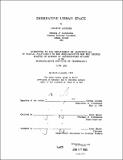Dissipative urban space
Author(s)
Loizides, Christis
DownloadFull printable version (16.37Mb)
Other Contributors
Massachusetts Institute of Technology. Dept. of Architecture.
Advisor
Julian Beinart.
Terms of use
Metadata
Show full item recordAbstract
Our life evolves as an interaction between predictable and unpredictable patterns. Variations and impediments stimulate our free, non-mechanical impulses towards unpredictable patterns. At the macroscopic level. history can be seen through an ever-repeating cycle moving from a cumulative trend towards order. to a decaying process. Through a similar viewing lens the past trends that regulated the physical context have been moving from concentrated and dogmatic ideologies. to dispersed and spontaneous ones. Since the 18th century. the Machine Age is geared towards the perfection of the machine. Within this frame of development. it took no more than 200 years for the trend of "machine perfection" to be explicitly applied. at the microscopic level. upon the urban environment. At the urban scale of design. The internationally accepted manifestations of the Chart of Athens have been projecting dogmatic patterns of development: The ''ideal" definitions of uses and "orderliness", inside and outside the built shells. have brought about the problem of segregating the liveliness of the city. Such regulating orders have negated the particularities of the public spaces: the spaces where the mixture of both intended and unintended patterns of activities. and regulated and unregulated forms. acclaimed publicness through time. The physical structure of all urbanizations is the result of the antagonistic interaction between concentrated totalities on the one hand. and dispersive partialities on the other. The first process is the product of the aforementioned deterministic development while the second one is the more unpredictable. evolutionary development that follows. My goal ·is to bring both processes into equal consideration when taking on the role of shaping a micro- scale. public space. It seems that the recent acknowledgments qualities in the "street", the "square". the "19th-century fabric", are weak in challenging the negative aspects of the International style. They still do not escape from generating guiding and deterministic environments. Dissipative urban space aims at a rewardingly rich public experience by embodying. yet not determining. both regulated and "unregulated" physical patterns.
Description
Thesis (M.S.)--Massachusetts Institute of Technology, Dept. of Architecture, 1985. MICROFICHE COPY AVAILABLE IN ARCHIVES AND ROTCH. Includes bibliographical references.
Date issued
1985Department
Massachusetts Institute of Technology. Department of ArchitecturePublisher
Massachusetts Institute of Technology
Keywords
Architecture.